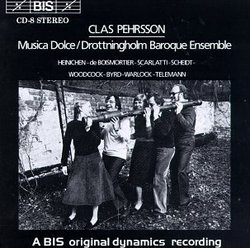| All Artists: Johann David Heinichen, Joseph Bodin de Boismortier, Alessandro Scarlatti, Samuel Scheidt, Clement Woodcock, William [Composer] Byrd, Peter Warlock, Georg Philipp Telemann, Drottningholm Baroque Ensemble Title: Clas Pehrsson Members Wishing: 0 Total Copies: 0 Label: Bis Release Date: 7/12/1993 Album Type: Import Genres: Dance & Electronic, Classical Styles: Chamber Music, Forms & Genres, Concertos, Historical Periods, Baroque (c.1600-1750), Instruments, Reeds & Winds Number of Discs: 1 SwapaCD Credits: 1 UPCs: 750582036224, 7318590000083 |
Search - Johann David Heinichen, Joseph Bodin de Boismortier, Alessandro Scarlatti :: Clas Pehrsson
 | Johann David Heinichen, Joseph Bodin de Boismortier, Alessandro Scarlatti Clas Pehrsson Genres: Dance & Electronic, Classical
|
Larger Image |
CD Details |
CD ReviewsMusic for Recorder Ensemble from the 16th to the 20th Centur Leslie Richford | Selsingen, Lower Saxony | 08/10/2005 (5 out of 5 stars) "First, some further information about the contents of this CD. The pieces by Heinichen, Alessandro Scarlatti and Telemann are standard-style baroque works for one or more recorders and strings. The solo part is played by Clas Pehrsson on diverse historical recorder types, assisted by his Musica Dolce recorder ensemble and the Drottningholm Baroque Ensemble. The Browning by Woodcock is from the 16th century, the pieces by Byrd and Scheidt are from the early 17th century, all played by Musica Dolce. The two concertos by Boismortier were, in fact, written for transverse flutes and are here played in a transcription for alto and tenor recorders. Peter Warlock's Capriol Suite, finally, was written in the 1920's for string orchestra and is here played in Stanley Taylor's transcription for recorder ensemble. Although this is a modern piece, it begins with several renaissance-style dances and, in the end, it is only the last movement, entitled "Mattachins", which sounds more modern.
As usual, BIS document the CD extremely well, and the booklet informs the listener that the recording sessions took place between 1974 and 1976 at Wik Castle in Sweden. Of course, these are analogue recordings, and if you listen closely, you will hear a little distortion at one or two points. Also, there is some "pre-echoing" from the tapes to be heard between tracks. Having said all that, I should add that Clas Pehrsson and his team do a wonderful job of presenting this highly unusual material. Thank God that BIS keep most of their old recordings on the market - this one is worth its weight in gold, both for the music and for its documentary value as a testimony to the beginnings of the Early Music Movement in Sweden." |

 Track Listings (28) - Disc #1
Track Listings (28) - Disc #1